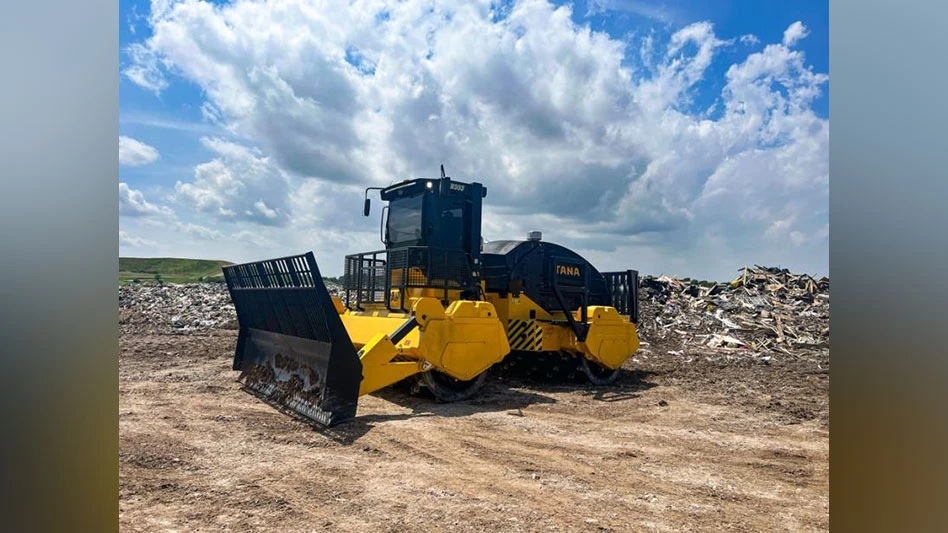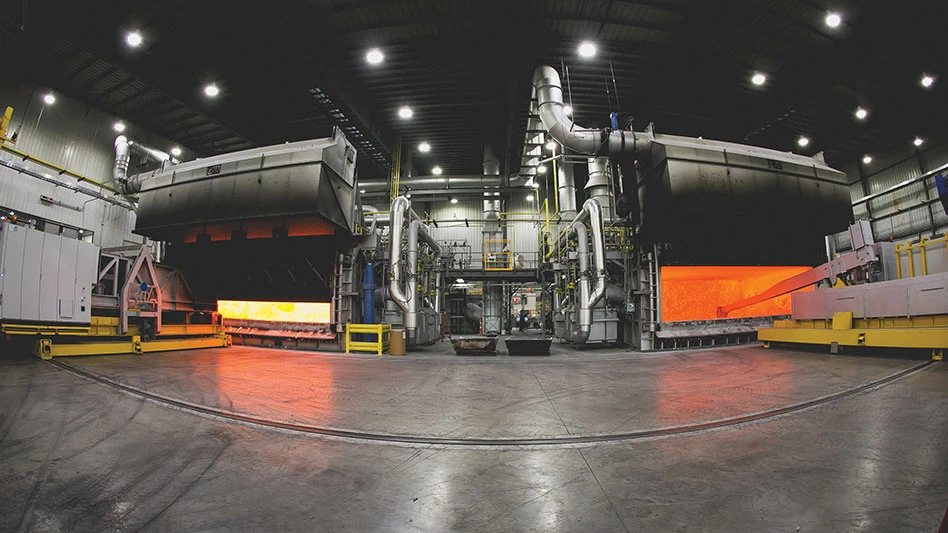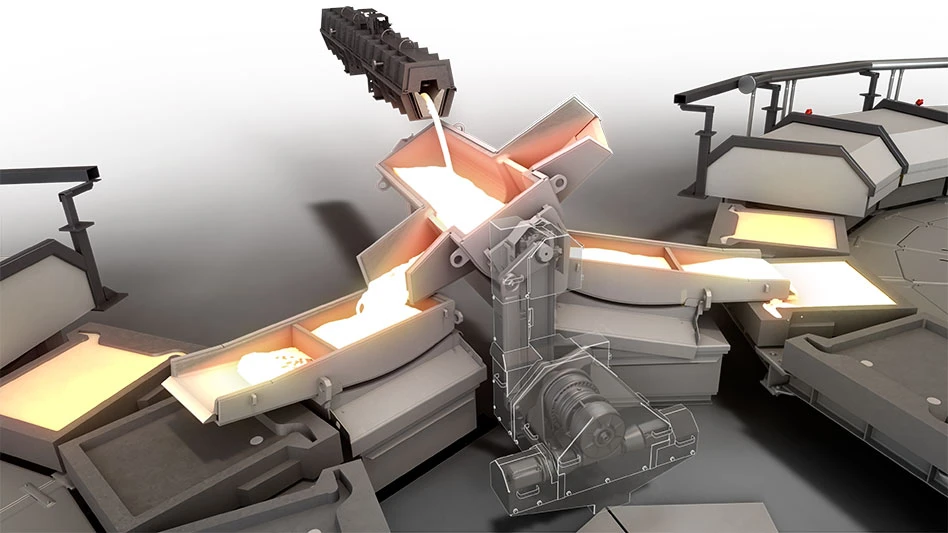Being an industry giant is supposed to offer advantages in terms of buying power and economies of scale. Leaders of OmniSource Corp., Fort Wayne, Ind., decided to try those advantages out in late 1999 and early 2000 when they researched and implemented a program to build a fleet of scrap handling machines in cooperation with one chosen equipment manufacturer.
“We began with a company-wide review of the types of equipment we currently operate,” remarked OmniSource ferrous division operations manager Jeff Bauer in early 2000. “The result was an intensive evaluation of scrap material handlers offered by several manufacturers in an effort to standardize our equipment fleet.”
In the first quarter of 2000, the company announced jointly with Caterpillar Inc., Peoria, Ill., that a long-term fleet building and management program had been reached. As conceived, OmniSource’s “Crane 2000” program would standardize the company’s material handling fleet with the intention of reducing operating and maintenance costs, as well as downtime.
“The Cat product line, maintenance support, and dealer network is unparalleled,” OmniSource vice president of the Ohio Ferrous Division Joel Beren said at the time. “We needed to be sure that one supplier could service all of our facilities and Caterpillar meets those needs.”
With more than one year having passed since the program was launched, OmniSource now finds itself with a growing fleet of Cat-yellow scrap handlers and some experience to evaluate how the fleet program has worked.
UNIFORMITY DECISIONS
One of the benefits of the Crane 2000 program was to build a more uniform fleet, and to a large extent that has been achieved. But according to John Marynowski, president of the OmniSource Corp. Ferrous Group, scrap operations are diverse enough to prohibit the same exact model being installed at all locations.
“Different situations call for different machines,” says Marynowski. “We have smaller machines that we request on wheels for some operations. We’re buying a lot of the 345 and 350 model scrap handlers because that’s a good size crane, but we’ve also bought some larger ones,” he notes.
“The largest ones feed the shredder. Really, what we’ve found is that feeding the shredder, you’ll use a larger crane with a larger grapple for the sizable feedstock that goes to the shredder,” says Marynowski. “Larger cranes have more reach and a better payload as far as weight it can pick up and feed the shredder. We’re settling on the 345 and 350 for the shredder feeds.”
While the varying operations occurring at OmniSource’s 30 locations prohibit a completely uniform fleet, cost efficiencies have been achieved by the company’s ability to use newer, more productive machines exclusively.
“A good example is in our large Toledo operation. Our original thought process to handle the tons we do at that location was that we would need to put in 16 to 18 cranes,” says Marynowski. “But because these cranes are so efficient and they avoid downtime, we’re getting by with 12 cranes, and may possibly add a 13th. When the uptime is there with reliable machines, you really benefit.”
Such an impact is harder to measure at smaller yards, he acknowledges. “When you have a high production, high-volume operation, you can see that efficiency,” says Marynowski. “It’s not like a smaller yard, where you need two cranes and there isn’t much of a question. At smaller yards, though, our maintenance costs are pretty consistent compared to what we could run into with older units.”
In a business where many costs are variable-costs of scrap purchased, energy costs, prices of scrap sold to mills-the agreement has allowed OmniSource to achieve consistency in one area.
“That’s a nice benefit: our equipment costs are consistent,” Marynowski remarks. “You don’t have those unpleasant surprises. You’re dealing with fixed costs instead of variable costs.”
LEASING OR BUYING
The deal structured between the two companies was designed with flexibility, says Marynowski, not only in terms of which machines can be ordered but as far as buying or leasing.
“We’re doing a little bit of both buying and leasing,” he comments. “Predominantly, what we’ve done is under a lease program, but the program offers an option to buy the machine at the end of the lease. We are in essence taking ownership if that’s what we decide to do.”
The company looks at operating hours as a gauge that provides them with key information. “We’re trying to put a machine in place for 15,000 operating hours. For us to be efficient and to get an optimum return on what we’re doing, we have to come as close to that 15,000 hours as possible,” says Marynowski. “Optimally, you’re looking at 15,000 hours for the life of that crane, whether it is a three-year program or a five-year program.”
On the one hand, if the lease comes to an end and not that many operating hours have been recorded, OmniSource has the opportunity to purchase a machine that can be expected to perform for quite a while longer. But Marynowski notes there is a downside to this circumstance, as well. “If we miss that 15,000 hours figure on the low side, that has not been a good use of the machine.”
KEEPING ALL PARTIES HAPPY
For the fleet agreement deal to last into the future, three groups will have to look upon the program in a positive light: OmniSource, Caterpillar Inc., and the Cat equipment dealers servicing the agreement throughout the country.
Five Caterpillar dealers in Indiana, Ohio, Michigan and Illinois were instrumental in putting the original agreement together. Subsequent expansion by OmniSource has allowed more dealers in additional geographic regions to become involved.
“What Caterpillar has done, as we expand, is we have the same general contract we signed with Caterpillar working with the local dealership wherever we may go,” says Marynowski. “Overall, the dealers have been very cooperative. Their response time has been great.”
A Cat dealer in Georgia is the newest one to get involved, as OmniSource purchased a scrap facility in Athens, Ga., earlier this year, and is now installing a shredder and equipment to feed it.
“From the response that I have had, including talking to dealers at the 2001 ISRI Convention, they seem to be happy with the deal,” says Marynowski. “As we buy cranes, it goes through the dealership, so they get the order, plus they get revenue from the maintenance standpoint.”
As outlined in early 2000 when the deal was announced, the multi-year agreement calls for the replacement of more than 100 material handlers and wheel loaders over a five-year period. Much of the initial purchasing of machinery has now occurred. “Our major influx of cranes was probably in the first three quarters of 2000,” says Marynowski.
But from OmniSource’s viewpoint, creating a fleet of newer, same-brand scrap handlers has proven so beneficial that the company is doing the same thing for other types of material handling equipment.
“We’re now doing this for loaders, skid steers and forklifts,” notes Marynowski. “We looked at other suppliers for this type of equipment-just as we asked for proposals from several scrap handler manufacturers-but Caterpillar still came out on top as far was what we needed. It has worked out well for both of us.” RT
The author is editor of Recycling Today.
Get curated news on YOUR industry.
Enter your email to receive our newsletters.

Explore the June 2001 Issue
Check out more from this issue and find your next story to read.
Latest from Recycling Today
- Fenix Parts acquires Assured Auto Parts
- PTR appoints new VP of independent hauler sales
- Updated: Grede to close Alabama foundry
- Leadpoint VP of recycling retires
- Study looks at potential impact of chemical recycling on global plastic pollution
- Foreign Pollution Fee Act addresses unfair trade practices of nonmarket economies
- GFL opens new MRF in Edmonton, Alberta
- MTM Critical Metals secures supply agreement with Dynamic Lifecycle Innovations





